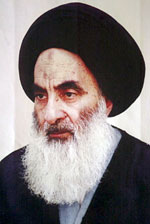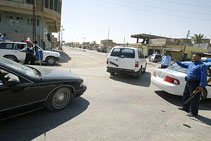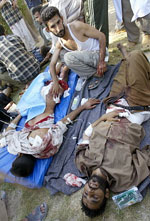|
Sistani in Last Ditch Talks to Save Najaf
 |
|
Sistani
was accused of 'leaving' Iraq at a crucial time, now he is back to
save the day (AFP)
|
NAJAF,
Iraq, August 26 (IslamOnline.net & News Agencies) - Iraq's top
Shiite scholar Grand Ayatollah Ali Al-Sistani arrived in Najaf
Thursday, August 26, and immediately entered into talks with
representatives of firebrand Moqtada Sadr in an eleventh hour attempt
to 'save' what is left from the holy city.
Talks
between Sistani and Sadr's camps started almost immediately, said a
spokesman for the ayatollah, but it was not clear if the two leaders
themselves had met face-to-face as officials said they had 24 hours to
find a solution.
A
24-hour ceasefire began immediately upon Sistani's arrival on the
order of Prime Minister Iyad Allawi - although the local governor said
hostilities would resume if a solution to the standoff against Shiite
militia was not found by then, reported Agence France-Presse (AFP).
The
US military, on its part, confirmed a temporary suspension in their
offensive.
After
a seven-hour journey, Sistani's motorcade stopped in Al-Saad, one of
the few relatively smart districts of Najaf, where the elderly
Iranian-born scholar went to rest in a house that police said belonged
to one of his close aides.
Set
back from the road in gardens behind a brick wall, the compound was
surrounded by a swarm of Iraqi police and national guardsmen, who
blocked off all streets leading to the district as a stream of
visitors flocked to the area.
One
US tank could be seen parked about 500 meters (yards) away.
"He's
in good health, but he's tired from the trip and he cannot talk to
anyone right now," said Najaf police chief Ghaleb Al-Jazairi.
None
of the many sheikhs coming to pay their respects following his medical
treatment in London said they had been allowed to meet Sistani,
according to AFP.
"I'm
happy Sistani's in my neighborhood, even if it's for a few days,"
said Ali Abdul Ameer, 54, gazing at the intense security detachment.
Ceasefire
Effective
 |
|
Sistani's
heavily guarded convoy rests in Najaf (AFP)
|
With
military operations called off, an enormous crowd forced its way into
Najaf's revered Imam Ali mausoleum, which has been cut off from the
outside world by heavy US bombardment and tank fire since Wednesday.
Sadr
has used the shrine as the headquarters of his Mehdi Army since his
spring uprising against foreign troops.
"We
answered the call of Sistani who ordered us to follow to Najaf to
break the siege. Police sort of tried to arrest us, but there was
nothing they could do. It's the end of the siege," one
demonstrator, Kazem Hamid, told AFP.
"We
have started contacts with Moqtada Sadr and in the coming hours we are
waiting, hoping that we will succeed in saving the city from
destruction," said Sistani spokesman Ahmed Al-Khaffaf, calling on
people not to enter Najaf.
Inside
the shrine, Medhi Kadhem Ali, commander of the militia's mortar
division confirmed that US troops were still heavily deployed.
"There
is a truce, but the Americans have only withdrawn from the market in
the Old City. They are still deployed along the edge of the cemetery
and in the sea of Najaf," he said.
He
said US troops opened fire on fighters who had tried to retrieve dead
and wounded stranded for days.
"I
hope that this is the end of the battle, but we have to wait for the
result of the talks," he said.
Sistani's
giant, ragged convoy, was greeted by thousands and escorted by police
and national guard patrol vehicles on the long 400-kilometre
(250-mile) journey north from Basra.
At
towns along the way, men, women, children and the elderly, lined the
streets to greet Sistani, regarded as a moderating influence in Shiite
Islam.
Behind
the vehicles containing the ayatollah and his aides, more than 1,000
cars, pick-up trucks, taxis and buses were packed with Shiite faithful
and Sadr supporters of all ages, waving banners and pictures of
Sistani.
The
ayatollah returned to Iraq Wednesday via Kuwait after three weeks'
treatment in London for a heart problem.
His
hurried return came after US forces smashed militia defenses to trap
hundreds of Sadr's supporters in the Imam Ali shrine, where a dozen
bullet holes were visible in its golden dome.
Bloody
Thursday
 |
|
In
Kufa, doctors struggled to cope with the enormous casualties (AFP)
|
Sistani's
arrival, however, was marked by a deadly day in Najaf's twin city of
Kufa, where 74 people were killed and 376 wounded in a mortar attack
on the main mosque and shooting at a march which was blamed on Iraq's
national guard, the health ministry said.
"The
Najaf hospital received 39 bodies and 255 wounded and the one in Kufa
25 bodies and 60 wounded," a health ministry official said.
The
bodies of another eight people killed in the demonstration and 42
wounded people were transported to Diwaniya, about 50 kilometers
(about 30 miles) east of Najaf.
Two
other bodies and 19 wounded were taken to a hospital in Hilla, about
60 kilometers (more than 35 miles) north of Najaf.
"We
cannot distinguish between those who died in the bombing of the Kufa
mosque and those who were killed in the demonstration," he said.
In
Kufa, doctors struggled to cope with the enormous casualties.
Pain-wracked
and bloodied patients, mostly men, were stretched out in the corridors
and garden of the town's Middle Euphrates hospital despite the intense
heat.
"There
were hundreds of us. We came early this morning to the mosque. We were
waiting for Sistani, inside and outside. Then at 8:00 am, two mortars
exploded, one near the outer gate and the other inside the
compound," said Hani Hashim.
Thousands
of people chanting slogans in support of Sadr and denouncing Allawi
were heading from Kufa for nearby Najaf when they came
under fire from national guardsmen as they passed a military
base, an AFP photographer said.
Later
national guards also fired on demonstrators from Diwaniya who tried to
enter Najaf from the east. An AFP photographer saw bloodstains and
shoes on the ground.
|